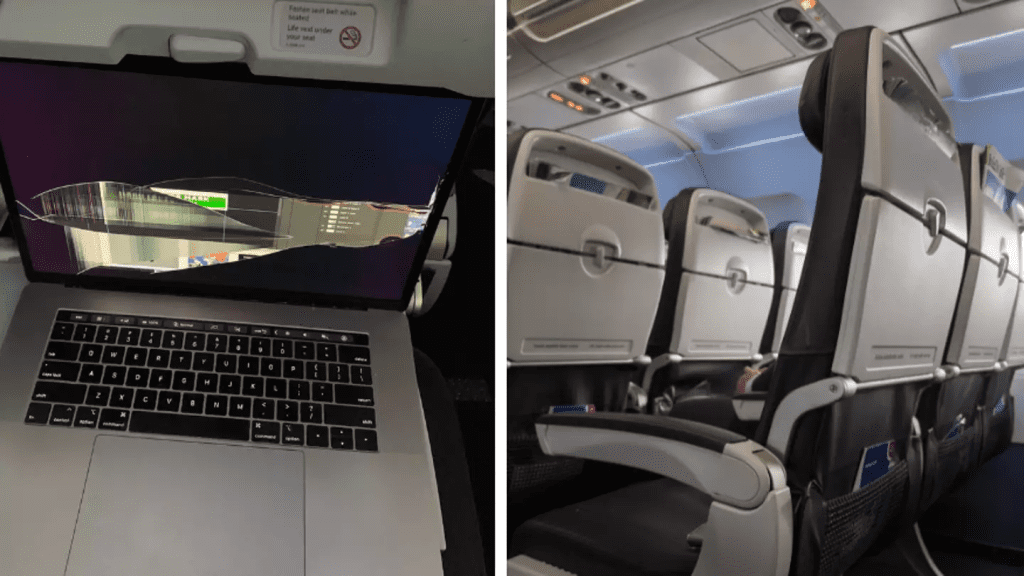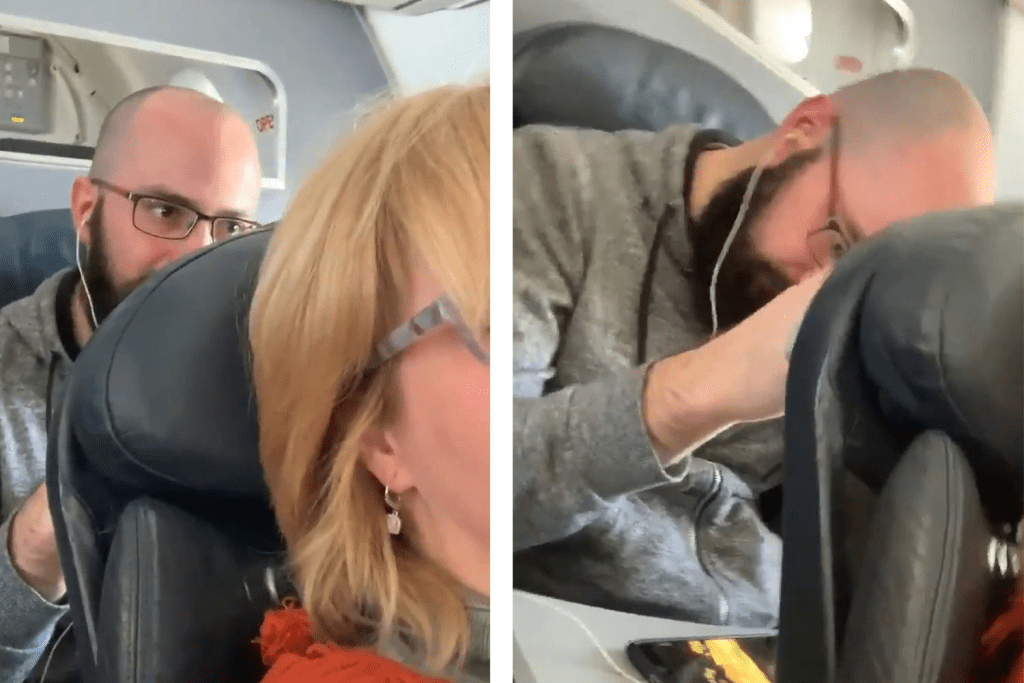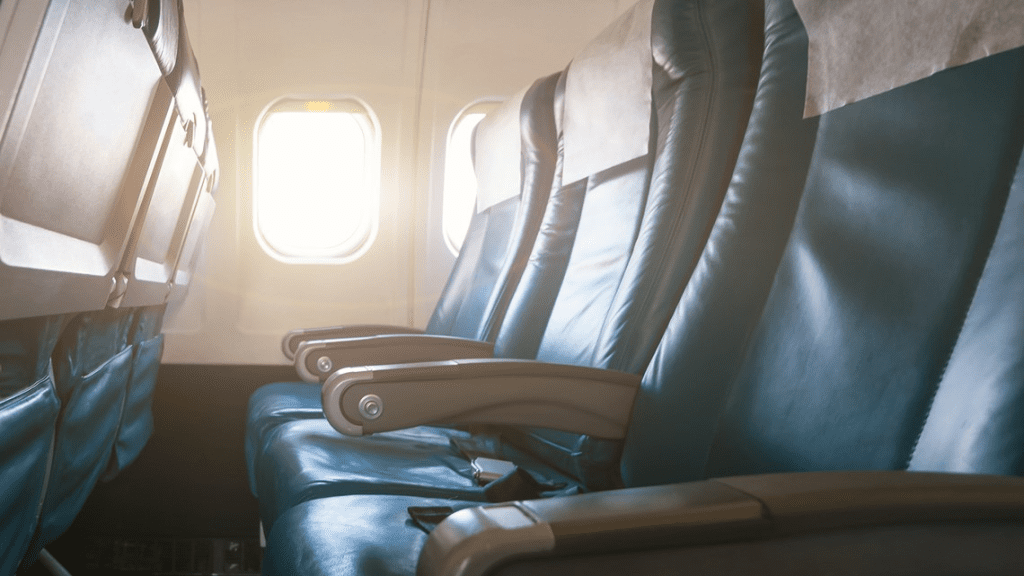The age-old debate on whether airplane seats should recline has taken center stage again after a Delta passenger, Pat Cassidy, suffered a costly mid-flight incident. The 37-year-old film producer and podcast host had his laptop screen shattered when the person seated in front of him reclined their seat. Cassidy took to social media to express his frustration, raising questions about airplane seating design and in-flight etiquette.

This incident has reignited the conversation on whether reclining airplane seats should still be part of the flying experience.
The Incident: A Laptop’s Demise
Pat Cassidy’s experience serves as a cautionary tale for travelers. While on a Delta Airlines flight, Cassidy placed his MacBook on the tray table, working as many passengers do. Unfortunately, when the person in front of him decided to recline their seat, the movement crushed his laptop screen.
Taking to Twitter, Cassidy posted a photo of his broken screen, accompanied by a complaint: “Small note for the suggestion box, maybe have a little warning sign or some way to prevent my laptop from being destroyed when the person in front of me reclines their seat.”
The damage to his laptop wasn’t the only thing that irked Cassidy. In a follow-up tweet, he expressed frustration with Delta’s response: “I really appreciate that your flight attendant came over to tell me that the passenger in front of me ‘needs to be able to recline’ and then asked him ‘if he was okay?’ as if your seat hadn’t just ruined my livelihood.”
Despite reaching out to Delta, Cassidy shared that not much had been done to resolve the issue, leaving him and his 13,000 Twitter followers questioning the airline’s customer service and policies around seat reclining.
The Bigger Picture: Reclining Seats Under Scrutiny
Cassidy’s misfortune isn’t an isolated case. The incident has reignited the long-standing debate over whether airplane seats should even recline, especially given how little space there is between rows on many flights. His story quickly gathered attention on social media, with users chiming in about their own frustrations with reclining seats.
One user tweeted: “The whole seating system in airlines needs to be disrupted. Rethought. Better. Its bulls***.” Another commented: “This is my biggest travel pet peeve. I think it’s rude to recline your seat.”

In-flight etiquette has become a hot topic, and opinions are split. Some passengers believe they have the right to recline, while others argue it’s inconsiderate in cramped quarters. This ongoing discussion raises the question: should airlines eliminate reclining seats altogether?
Delta Airlines CEO Weighs In on Reclining Etiquette
The debate over seat reclining is not new. In fact, Delta Airlines CEO Ed Bastian addressed the topic back in 2020 during an interview with CNBC. When asked about a viral video showing a man punching a woman’s seat after she reclined, Bastian acknowledged the right to recline but emphasized the importance of courtesy.
“I think customers have a right to recline,” Bastian said. “But I think that the proper thing to do is if you’re going to recline into somebody that you ask if it’s OK first and then you do it.”
While the CEO expressed that he never reclines his own seat, he also noted that he doesn’t object when someone reclines into his space. For many passengers, this raises the question of whether common courtesy is enough to prevent incidents like Cassidy’s or if airlines should make structural changes to address these issues.
The Rise of Pre-Reclined Seats: A New Solution?
The idea of eliminating reclining seats has been gaining traction in recent years, and some airlines have already started to adopt pre-reclined seats, particularly on short-haul flights. These seats offer a fixed recline, preventing the need for passengers to adjust them and reducing the likelihood of disputes.
Mark Hiller, CEO of Recaro, a leading German seat manufacturer, spoke about the benefits of pre-reclined seats. “The main advantage is increased living space, as a passenger’s living space is not intruded by recline,” Hiller stated. Additionally, these seats provide practical benefits for airlines, including reduced maintenance costs and improved reliability, as they have fewer moving parts.
With weight and fuel efficiency being major concerns for airlines, pre-reclined seats also offer an economic benefit. CNN reports that a typical airplane seat weighs between 15 and 22 pounds, and reducing this weight can result in significant fuel savings. Hiller emphasized that pre-reclined seats are “low weight and cost, with no mechanism, kinematics and so on required.”
As airlines explore ways to optimize space and cut costs, the trend of non-reclining seats could become more widespread, potentially solving the issue for good.
The Economics Behind Airline Seating Decisions
The debate over reclining seats isn’t just about passenger comfort or etiquette—it’s also about economics. Airlines constantly seek ways to maximize profit, which often leads to reduced legroom and denser seating arrangements. Reclining seats, while a standard feature for decades, may no longer be necessary in modern air travel, especially given the rise of pre-reclined alternatives.

Recaro’s pre-reclined seats are becoming a popular choice for short-haul flights, offering passengers a fixed angle of recline without the hassle of adjusting their seats. The fixed recline not only improves space but also reduces maintenance costs for airlines, since fewer moving parts mean fewer chances for mechanical failure.
Given the economic benefits and the potential for improved passenger satisfaction, it’s likely that more airlines will follow suit in adopting non-reclining seats in the future.
Should Reclining Seats Be Phased Out?
Cassidy’s broken laptop serves as a clear reminder that reclining seats can cause real problems. With many airlines moving towards fixed, pre-reclined seats, the future of reclining in-flight may be uncertain. But should airlines phase them out completely?
There’s no doubt that eliminating reclining seats would prevent incidents like Cassidy’s and likely reduce passenger conflicts. But for some travelers, the ability to recline during long flights remains a valued feature. The question, then, is whether passenger comfort outweighs the risks and potential inconveniences reclining seats pose.
Conclusion: Is It Time to Rethink Reclining Seats?
Pat Cassidy’s unfortunate experience on his Delta flight has sparked a broader conversation about airplane seating and in-flight etiquette. While reclining seats have long been a feature of air travel, incidents like Cassidy’s are leading many to question whether they still have a place in the modern flying experience.
As more airlines explore the use of pre-reclined seats, and as passengers continue to voice their opinions on seat etiquette, the future of reclining in-flight may soon be up for reconsideration. Whether it’s for safety, courtesy, or economic reasons, one thing is certain: the debate over reclining airplane seats is far from over.


